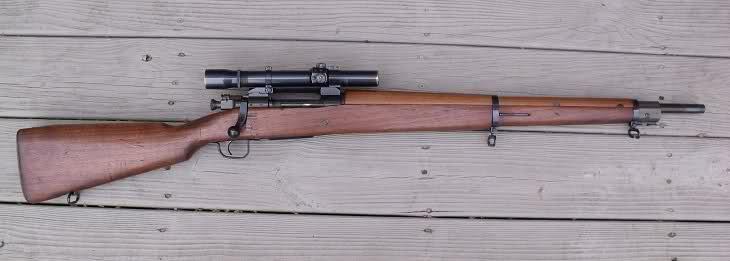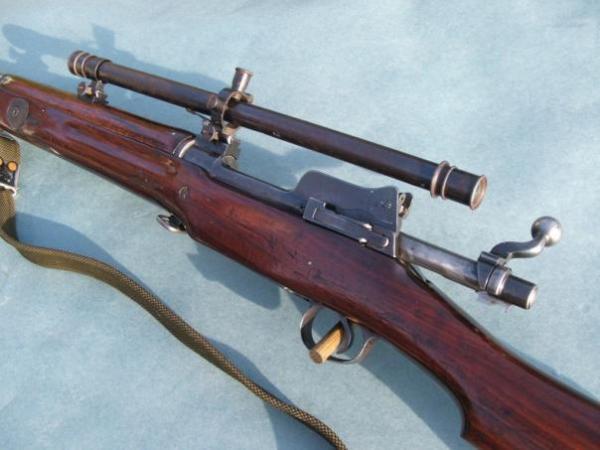If it wasn’t for that groove in the handguard, I might think the stock is a fairly recent replacement. The messing around with the muzzle band etc. could have been anyone I suppose. The roughness or lack of completion just reflects something that was never finished probably. If making a fake, why would it not be finished off?
Looks like “27" to me and that could be highly significant since as far as I know, the P14 was not on issue except as the (T) model with the Patt.18 scope or (F) backsight for Regular and Territorial use respectively. Would Enfield be rebarreling P.14s in 1927? I can't see why, unless it was one of those that had seen service in WWI, but would they bother with 10,000 new Winchester P14s supposedly in war reserves? Perhaps like the Aldis No3 and 4 scopes supposed to have been set aside, that never actually happened? Both reports come from The BritishSniper, but is there any proof? The odds and sods of scopes fitted up by Alex Martin to P.14s in WWII strongly suggests the Aldis scopes were not in fact kept in reserve, and the profusion of them found on sporting rifles in the 20s and 30s supports that.
The mount for the Ainley is quite different. I have photos on another drive, perhaps someone else has some handy? The mount fitted into the machined groove on the receiver wall and locked with two thumbscrews similar to what the No32 bracket came to use. There was a recess on the underside of the mount which mated with that square lug on top of the receiver ring, in order to support the mount, and perhaps absorb some recoil forces too.
That’s what I was referring to also previously. It’s a bit of a mystery as I can’t think of any European or British scope that would need that much clearance, unless it was an American target scope in spring loaded mounts., but then the spring would have to under expansion rather than compression!
There were some trials done for other mounts as well, which are detailed in The British Sniper. I believe these were Patt. 18 scopes fitted to Springfield rifles and adjustments, at least for windage, were in the mount via a dial positioned similar to Dr. Common’s sight or a Bren MkI sight. There’s a photo or two in the book. Relevant to this only to the extent that it shows experimental work was going on different concepts between the wars, albeit a very slow pace.
Third time we’ve misunderstood each other, but no worries, your English a lot better than my German!
I did refer to the back of the rear ring mount being flat, but it would not have to be entirely flattened off, it would probably have had a concave or semi-circular groove that the rounded portion of the locking lever would “roll into” as it was locked. There was probably some interference in the fit to give some compression and lock the mount in place. I hope that makes sense?
That’s good, it looked like it had had a blow on one forward corner and in fact I thought afterwards maybe both corners, which then made me wonder if someone was trying to remove some “play” in the fit by doing so. Regardless you can see how exposed that dovetail would be to damage with the scope removed. US scopes and mounts in general aren’t much of an example of anything I’m afraid, except fine workmanship and a failure to keep pace with developments, until the 1960s that is.
Those little shoulders are pointless IMO, but they took the designer’s fancy for whatever reason. The Mauser self-loading rifle of before WWI had a forward tapering dovetail scope base, and the Frenchused them in WWI as well. Fine idea as long as you have the mechanical advantage to pry them off again!
I agree, those are the most likely scenarios.
Perhaps there is some British-made scope from the 1930s that is less known which might be a fit? As in the case above with the Springfields, if the mounts and mag were being assessed the scope itself was irrelevant except as it facilitated the testing of repeatability in the mounts etc.
There might be some drawings or record of this rifle somewhere in the Pattern Room files.Information

Warning: This is a relatively older thread
This discussion is older than 360 days. Some information contained in it may no longer be current.
- Knowledge Library

- MKL Entry of the Month
- Australia
- Austro-Hungarian Empire
- Canada
- Czechoslovakia
- Denmark
- Finland
- France/Belgium
- Germany
- Italy
- Japan
- Norway
- Russia
- South America
- Sweden
- Switzerland
- Turkey
- United Kingdom
- United States
- Yugoslavia
- Is my rifle authentic or a fake?
- Jay Currah's Lee Enfield Web Site
- On-line Service Records (Canada)
- Technical Articles/Research
- Forum
- Classifieds

- What's New?
-
Photo Gallery

- Photo Gallery Options
- Photo Gallery Home
- Search Photo Gallery List
-
Photo Gallery Search
- Video Club

- iTrader













 PM
PM




